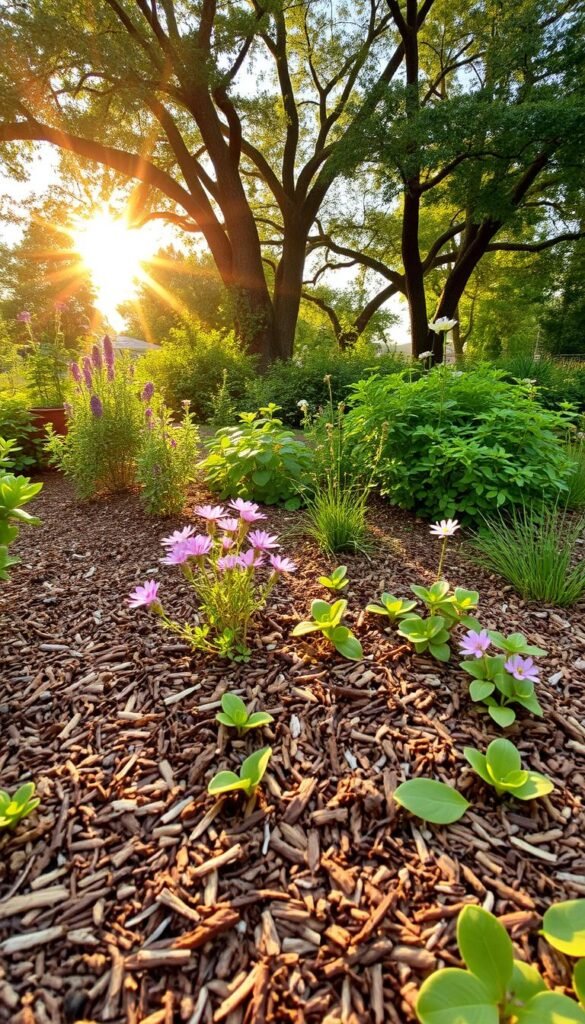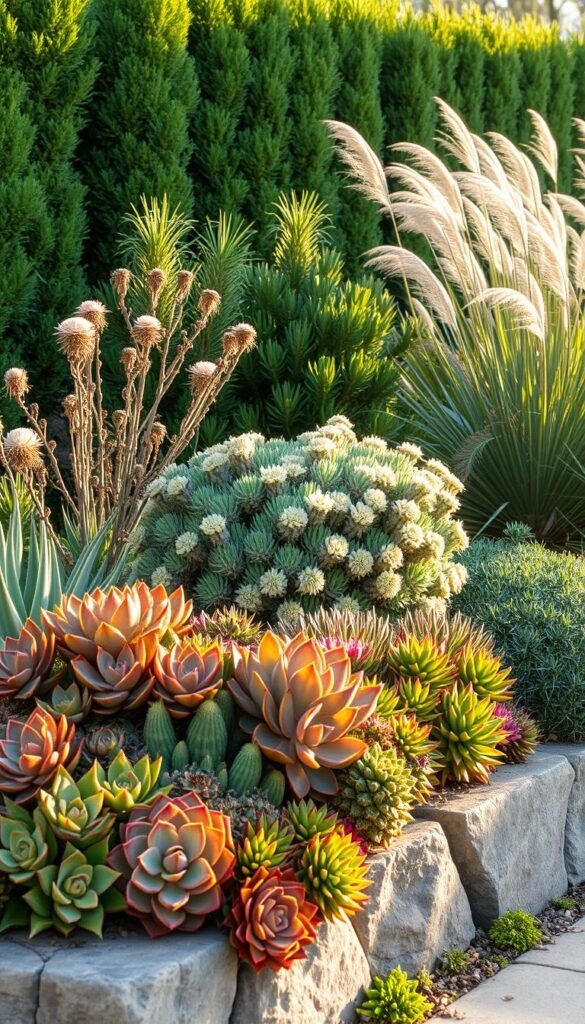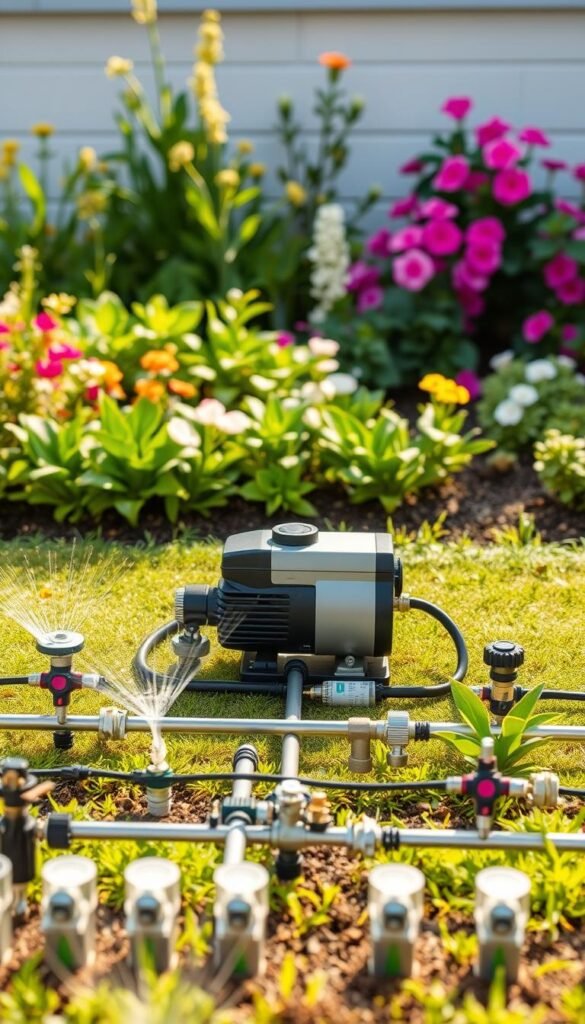Does your outdoor space feel like a never-ending chore? You’re not alone. Traditional gardening often demands hours of mowing, watering, and weeding just to keep things presentable. But here’s the secret: a thriving garden doesn’t have to drain your time or energy. By focusing on smart design and strategic plant choices, you can create a beautiful landscape that practically takes care of itself.
The Royal Horticultural Society confirms that reducing maintenance starts with understanding your space. Identify areas that consume the most effort—like fussy flower beds or thirsty lawns—and rethink them. For example, swapping high-maintenance grass for durable ground covers or hardy plants cuts weekly chores in half.
Smart landscaping also means working with nature, not against it. Grouping plants with similar needs prevents overwatering, while mulch suppresses weeds naturally. Pair these ideas with time-saving systems like drip irrigation, and you’ll reclaim weekends fast. Even better? A slightly wilder aesthetic isn’t just easier—it supports local pollinators too.
By planning upfront, you’ll save months of work later. Whether you’re drawn to structured sustainable layouts or free-flowing native gardens, the right approach lets you enjoy your oasis instead of laboring over it. Ready to transform your yard into a space that thrives with minimal input? Let’s dive in.
Designing Your Low-Maintenance Garden Blueprint

Ever wish your yard could work smarter, not harder? The secret lies in matching your space to its natural strengths. Start by becoming a detective in your own backyard—sunlight patterns, moisture levels, and soil conditions hold clues to effortless growth.
Understanding Your Garden’s Unique Conditions
Healthy soil is your garden’s best ally. A simple test kit reveals pH levels and nutrient gaps. Most local extension offices offer free analysis—use their insights to boost organic matter with compost. This creates a self-sustaining foundation where plants resist pests naturally.
Track how light moves across your garden throughout the day. Full-sun areas might host drought-tolerant perennials, while shady corners could become mossy retreats. Remember: Plants thrive when placed where they’re naturally suited, slashing your watering and pruning time.
Incorporating Hardscape and Structural Elements
Strategic landscaping reduces upkeep dramatically. Replace high-maintenance grass with:
- Permeable gravel paths that prevent puddles
- Stone patios that double as entertainment zones
- Terraced walls that control erosion
Choose materials like composite decking or natural stone that weather beautifully. As experts note, these features create visual interest while shrinking areas needing care. For urban spaces, container arrangements offer similar benefits in vertical layouts.
By blending smart observations with permanent structures, you’ll craft a low-maintenance garden that flourishes year after year—with weekends reclaimed for relaxation.
Building a Low-Maintenance Garden: Design Strategies for Busy Gardeners

Want more beauty with less work? The secret lies in choosing nature’s toughest performers and smart systems that handle the heavy lifting. Let’s explore three game-changing approaches that keep your green space thriving while freeing your schedule.
Selecting Resilient Plants and Low-Maintenance Varieties
Plants that practically grow themselves exist—you just need to know where to look. The Royal Horticultural Society’s Award of Garden Merit (AGM) acts like a quality seal, identifying varieties proven to flourish with minimal care. Lavender and Russian sage thrive in sunny spots, while hostas brighten shady corners without fuss.
Evergreen shrubs like boxwood or holly offer year-round structure without leaf-raking marathons. For vertical impact, self-clinging climbers like Boston ivy scale walls unaided. “The right plant in the right place cuts maintenance by 80%,” notes landscape designer Lauren Springer.
Utilizing Mulch, Gravel, and Irrigation Systems
Two inches of bark chips or gravel blocks weeds while locking in moisture. Organic mulches like compost gradually feed soil nutrients, while inorganic options last longer. Pair this with drip irrigation—a system that waters roots directly—and you’ll slash both weeds and watering time.
Creative Uses for Containers and Raised Beds
Large containers (18”+ diameter) dry out slower than small pots, making them ideal for low-maintenance flowers for raised beds. Elevate planters to waist height to reduce bending, or cluster them as movable focal points. For veggies, cedar beds with quality soil mean fewer pests and richer harvests.
Combine these strategies, and your garden becomes a self-sufficient retreat that grows lovelier each season—with barely any input from you.
Simplifying Routine Garden Care for Busy Lives

What if your garden could practically care for itself? Modern solutions let you maintain lush foliage and vibrant blooms without sacrificing weekends. The key lies in pairing smart habits with technology that works while you’re busy elsewhere.
Implementing Efficient Watering and Pruning Techniques
Ditch the hose shuffle. Automated irrigation delivers precise water amounts through drip lines or soaker hoses, targeting roots directly. Smart controllers adjust schedules based on weather data—some even sync with smartphone apps. “Zoned systems cut summer water use by 50% while keeping plants healthier,” notes EPA’s WaterSense program.
Prune smarter, not harder. Trim shrubs right after flowering to encourage natural shapes. For trees, focus on removing dead branches annually. Compact varieties like dwarf hydrangeas stay tidy for years, reducing pruning needs. Pair these with time-saving gardening methods like mulching to suppress weeds.
Create a 10-minute weekly routine:
- Check soil moisture with a finger test
- Remove weeds before they seed
- Deadhead spent blooms
Seasonal checklists prevent overwhelm. In spring, refresh mulch. Come fall, divide perennials. By matching tasks to nature’s rhythm, you’ll keep garden care quick and effective year-round.
Refining Your Outdoor Oasis for Year-Round Enjoyment
Imagine a garden that evolves beautifully with each season while demanding little from your schedule. Start by rethinking your lawn—the Royal Horticultural Society recommends replacing small grass areas with gravel paths or lush borders filled with native shrubs. These swaps eliminate mowing while adding texture through ornamental grasses and winter-blooming perennials.
Let nature handle the details. Alpine plants in rock gardens thrive with minimal water, while cracks between pavers become miniature ecosystems for creeping thyme. For effortless color, plant long-lived bulbs like daffodils—they’ll multiply yearly without replanting. Drought-tolerant seed mixes create meadows that buzz with pollinators yet need mowing just once a year.
Blend edibles with ornamentals for dual-purpose beauty. Blueberry bushes offer spring flowers and summer fruit, while rosemary adds fragrant structure. As your garden matures, adjust pruning and mulching routines—established plants need less care. Evergreen shrubs like holly provide winter interest through glossy leaves and bright berries.
Embrace imperfections. Wind-sown flowers in gravel beds or creative container arrangements add whimsy without work. Over time, your space becomes a living tapestry that grows lovelier with minimal input—proof that smart design lets you enjoy nature’s rhythm rather than fight it.






